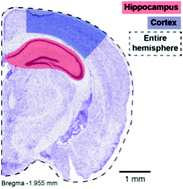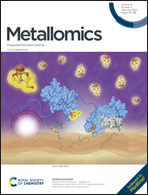Characterising the spatial and temporal brain metal profile in a mouse model of tauopathy†
Abstract
A dysregulation in the homeostasis of metals such as copper, iron and zinc is speculated to be involved in the pathogenesis of tauopathies, which includes Alzheimer's disease (AD). In particular, there is a growing body of evidence to support a role for iron in facilitating the hyperphosphorylation and aggregation of the tau protein into neurofibrillary tangles (NFTs) – a primary neuropathological hallmark of tauopathies. Therefore, the aim of this study was to characterize the spatial and temporal brain metallomic profile in a mouse model of tauopathy (rTg(tauP301L)4510), so as to provide some insight into the potential interaction between tau pathology and iron. Using laser ablation-inductively coupled plasma-mass spectrometry (LA-ICP-MS), our results revealed an age-dependent increase in brain iron levels in both WT and rTg(tauP301L)4510 mice. In addition, size exclusion chromatography-ICP-MS (SEC-ICP-MS) revealed significant age-related changes in iron bound to metalloproteins such as ferritin. The outcomes from this study may provide valuable insight into the inter-relationship between iron and tau in ageing and neurodegeneration.



 Please wait while we load your content...
Please wait while we load your content...